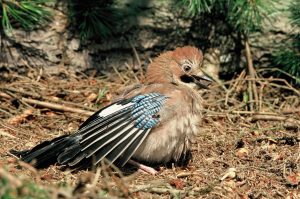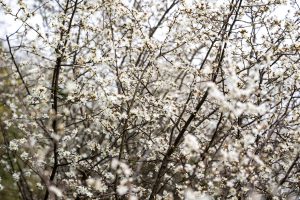Garden Bird Feeding Survey Results
Research by the British Trust for Ornithology's garden bird feeding survey showed that the number of different birds visiting the average feeding station has risen from16 in the 1970s to 23 last winter.
The study, which takes place in 250 gardens nationally between October and March every year, found goldfinches were now seen in 61 per cent of gardens – up from only one per cent in the 1970s, long-tailed tits up 26 per cent and wood pigeons up 62 per cent.
In addition to regular visitors, many unusual species have been sighted in GBFS participant’s gardensover the years. These include: Rock Pipit, Hawfinch, Raven, Twite, Snow Bunting, Lapland Bunting and Chough. Summer visitors have even made an appearance such as Swallow, House Martin, Pied Flycatcher, Yellow Wagtail, Wheatear, Ring Ouzel, Whinchat, Tree Pipit, Lesser Whitethroat and Wood Warbler.
A few wetland birds have been spotted searching for food in gardens including Mandarin looking for grain, Jack Snipe and Woodcock enjoying chopped peanuts and mealworms.
Farmland birds coming to gardens for seed were Grey Partridge and Corn Bunting.
The GBFS results suggest that new bird foods and associated feeding equipment have opened the garden gate to many once-infrequent garden visitors. A total of 96 species were recorded feeding in gardens last winter, demonstrating how important our gardens can be for birds during this time of year.
Winter feeding has been shown to increase bid survival rates across a number of species and enhances the success of breeding during the following spring.
Last winter was particularly special due to it being one of the coldest winters in 100 years.The effects of last winter meant that:
Recorded in 279 sites across UK. Gardens are chosen carefully from existing members of the BTO Garden BirdWatch survey, ensuring good coverage across the UK and a roughly even split between rural and suburban gardens.
Top 12 species
Other species
The study, which takes place in 250 gardens nationally between October and March every year, found goldfinches were now seen in 61 per cent of gardens – up from only one per cent in the 1970s, long-tailed tits up 26 per cent and wood pigeons up 62 per cent.
In addition to regular visitors, many unusual species have been sighted in GBFS participant’s gardensover the years. These include: Rock Pipit, Hawfinch, Raven, Twite, Snow Bunting, Lapland Bunting and Chough. Summer visitors have even made an appearance such as Swallow, House Martin, Pied Flycatcher, Yellow Wagtail, Wheatear, Ring Ouzel, Whinchat, Tree Pipit, Lesser Whitethroat and Wood Warbler.
A few wetland birds have been spotted searching for food in gardens including Mandarin looking for grain, Jack Snipe and Woodcock enjoying chopped peanuts and mealworms.
Farmland birds coming to gardens for seed were Grey Partridge and Corn Bunting.
Benefits of feeding birds
The GBFS results suggest that new bird foods and associated feeding equipment have opened the garden gate to many once-infrequent garden visitors. A total of 96 species were recorded feeding in gardens last winter, demonstrating how important our gardens can be for birds during this time of year.
Winter feeding has been shown to increase bid survival rates across a number of species and enhances the success of breeding during the following spring.
Last winter was particularly special due to it being one of the coldest winters in 100 years.The effects of last winter meant that:
- A productive breeding season in 2010 increased populations of Blue Tit, Great Tit, Dunnock and Chaffinch.
- An abundance of berries and fruits, due to a dry Jan-June, fuelled extra winter thrushes.
- Limited cereal, tree seed and berry yields on the Continent encourage migrants such as Waxwings.
- Heavy rain in October causing flooding attracted waterfowl, Kingfisher, Pied Wagtail and Grey Wagtail.
- A mild February prompted early nesting amongst Woodpigeon, Collared Dove, Robin and thrushes.
- Bird baths busy with some Brambling and Waxwing in March due to dry weather with minimal rainfall.
GBFS Results Winter 2010/2011
Recorded in 279 sites across UK. Gardens are chosen carefully from existing members of the BTO Garden BirdWatch survey, ensuring good coverage across the UK and a roughly even split between rural and suburban gardens.
Top 12 species
| Robin | 100% | Coal Tit | 93.2% |
| Blackbird | 99.6% | Greenfinch | 91.8% |
| Blue Tit | 98.9% | Goldfinch | 87.5% |
| Chaffinch | 98.9% | Collared Dove | 85.3% |
| Great Tit | 98.6% | Woodpigeon | 84.9% |
| Dunnock | 98.2% | Starling | 78.5% |
Other species
| House Sparrow | 77.8% | Fieldfare | 17.2% |
| Long-tailed Tit | 74.9% | Reed Bunting | 16.8% |
| Magpie | 71.7% | Feral Pigeon | 15.4% |
| Great Spotted Woodpecker | 60.9% | Lesser Redpoll | 15.4% |
| Song Thrush | 59.1% | Tree Sparrow | 15.4% |
| Sparrowhawk | 54.8% | Yellowhammer | 13.6% |
| Jackdaw | 54.1% | Herring Gull | 13.3% |
| Siskin | 52.3% | Goldcrest | 11.8% |
| Wren | 44.8% | Stock Dove | 10.4% |
| Brambling | 43.7% | Grey Wagtail | 9.3% |
| Pied Wagtail | 42.7% | Marsh-Willow Tit | 8.6% |
| Carrion Crow | 40.9% | Mallard | 6.8% |
| Nuthatch | 35.8% | Moorhen | 6.5% |
| Pheasant | 35.8% | Common Gull | 5.0% |
| Blackcap | 29.7% | Treecreeper | 5.0% |
| Bullfinch | 29.4% | Heron | 3.6% |
| Rook | 25.4% | Lesser Black-backed Gull | 3.6% |
| Redwing | 23.3% | Buzzard | 3.2% |
| Black-headed Gull | 20.8% | Red-legged Partridge | 3.2% |
| Mistle Thrush | 19.7% | Kestrel | 2.9% |
| Jay | 18.6% | Chiffchaff | 1.8% |
| Green Woodpecker | 1.8% | Common Sandpiper | 0.4% |
| Hooded Crow | 1.8% | Corn Bunting | 0.4% |
| Linnet | 1.8% | Crested Tit | 0.4% |
| Red Kite | 1.8% | Goosander | 0.4% |
| Tawny Owl | 1.8% | Goshawk | 0.4% |
| Meadow Pipet | 1.4% | Green Sandpiper | 0.4% |
| Snipe | 1.4% | Greylag Goose | 0.4% |
| Waxwing | 1.4% | Jack Snipe | 0.4% |
| Barn Owl | 0.7% | Little Grebe | 0.4% |
| Hen Harrier | 0.7% | Little Gull | 0.4% |
| Lesser-spotted Woodpecker | 0.7% | Little Owl | 0.4% |
| Merlin | 0.7% | Mandarin Duck | 0.4% |
| Peregrine Falcon | 0.7% | Mealy Redpoll | 0.4% |
| Raven | 0.7% | Mute Swan | 0.4% |
| Ringed-necked Parakeet | 0.7% | Grey Partridge | 0.4% |
| Rock Dove | 0.7% | Rock Pipit | 0.4% |
| Skylark | 0.7% | Swallow | 0.4% |
| Water Rail | 0.7% | Teal | 0.4% |
| Woodcock | 0.7% | Whitethroat | 0.4% |
| Black Redstart | 0.4% | Wigeon | 0.4% |
| Canada Goose | 0.4% | Willow Warbler | 0.4% |


